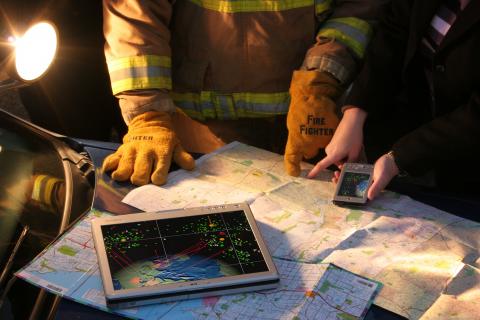
Disaster Recovery
Disaster Recovery
Solutions from response to resilience
Solutions from response to resilience
Pacific Northwest National Laboratory develops tools and partnerships to better anticipate, protect against, and respond effectively to emergencies and aid disaster recovery.
(Photo by Gorodenkoff | Shutterstock.com)
Before and after disaster strikes, Pacific Northwest National Laboratory (PNNL) is ready with resources, tools, and partnerships to help stakeholders better anticipate, respond effectively to, and recover from emergencies.
Through strong regional and nationwide networks—and resources such as the Northwest Regional Technology Center—PNNL connects researchers and capabilities with private and public stakeholders to aid recovery from potential natural, human-made, and other emerging threats. Armed with extensive experience working with and a deep understanding of the first responder community, staff help identify community needs and requirements before, during, and after a major disaster; promote community resilience; and prepare the first responder community for the future.
Delivering solutions for disaster recovery

Across all domains—air, land, sea, and cyber—PNNL serves as a primary resource for working with first responders, emergency management, public safety professionals, academia, and the private sector to define and prioritize technology needs. PNNL has expertise in convening diverse stakeholder groups to develop recovery frameworks for complex emergency response and disaster recovery situations, including those involving biothreat agents and radiological/nuclear hazards. Resulting solutions have addressed economic implications, public health impacts, and decision-making frameworks to prioritize disaster recovery efforts.
For example, PNNL joined the U.S. Department of Homeland Security and the U.S. Defense Threat Reduction Agency in collaborating with the Seattle Urban Area Security Initiative to conduct the Interagency Biological Restoration Demonstration Program. The program provided coordinated, system-level approaches for the recovery and restoration of urban areas, military installations, and critical infrastructure after the aerosol release of a biological agent. The effort resulted in a first-of-its-kind regional recovery framework for a biological incident. The framework for this was used by regional partners when confronting the COVID-19 response.
Collaborating to advance technology
When faced with a disaster, first responders across the nation need advanced technologies to enhance health, safety, and performance in complex threat environments. PNNL has led collaborations to envision first responder needs years in the future and accelerate development and integration of technology solutions to significantly improve the safety and capability of first responders in disaster recovery.
As new technologies for firefighters, law enforcement, and emergency medical services come to market at a record pace, PNNL connects technology developers and end users to:
- Identify critical technology needs and requirements to inform the federal research and development agenda.
- Enable technology testing and evaluation.
- Provide unbiased information to support acquisition and/or implementation.
- Accelerate technology development and deployment.

PNNL has convened government sponsors and regional stakeholders in large metropolitan areas to develop solutions that reduce the time and resources required to recover wide urban areas, military installations, and other critical infrastructures after a catastrophic chemical, biological, or radiological incident. These programs seek to:
- Develop/refine guidance, plans, and decision frameworks for long-term disaster recovery that can be leveraged for other parts of the country and internationally, as applicable.
- Identify, develop, refine, demonstrate, and transition technologies and standards that support recovery prioritization, planning, and operations.
- Better understand the public health strategies and challenges related to long-term recovery and recommend changes as needed to public health guidance and/or plans.
PNNL has also designed tools like the National Response Framework Policy Analysis Tool that can be utilized to better understand the foundational management doctrine for how the nation responds to and recovers from all types of catastrophic incidents and disasters. The tool provides a user-friendly way to more easily convey the requirements assigned to the federal government versus those assigned to individuals, families, and households for a particular disaster response.
Building partnerships for better disaster recovery
As a cornerstone of this effort, PNNL operates the Northwest Regional Technology Center, a virtual resource to support local and regional preparedness, resilience, response, and disaster recovery. The center enables homeland security solutions for emergency responder communities; federal, state, and local agencies; and private sector stakeholders in the Northwest and beyond.
Through the center, PNNL participates in partnerships and programs that foster a collaborative spirit with emergency responder communities and generate forward-leaning discussions about emerging and disruptive technology. The center matches PNNL researchers and capabilities with private and public stakeholders to address current and emerging challenges in disaster response, recovery, and resilience. This gateway connects subject matter experts with those in need of better understanding of, training with, and exposure to new and emerging technologies.

